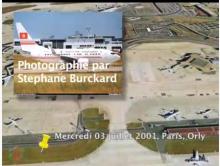Tunisian presidential plane-spotting
Sometimes the data you need for your campaign can be found in unlikely places.
'Planespotters' track and photograph planes all over the world and share their data online. It is a personal passion many pursue for pleasure and entertainment which has grown into a global community; helped by sites like Airliners.net, which provide spaces for amateur plane enthusiasts to post their photos.
In 2007, Tunisian blogger Astrubal came across several images of the Tunisian presidential plane on a planespotting site, taken between 2001 and that year. Astrubal cross-referenced the plane’s sightings against government reports of official travel. His efforts revealed that most of the presidential plane trips had been unreported.
The presidential plane had been outside the country at least 13 times in a period when only three official trips had been reported. Then-president Zine el-Abidine Ben Ali was known for rarely leaving the country. So who had been using the plane, and why?
Seeking answers, Astrubal created a DailyMotion video, laying plane photos and the dates of the sightings over a Google Earth map to show exactly where and when the plane had been seen. The video was spread widely, gaining the attention of Tunisia's mainstream media. Questions abounded: Who was using the presidential plane? Was it being used for diplomatic or personal purposes? Why were there no reports of these trips in the media? And, more generally, who was allowed to use the plane? And who controlled this?
Astrubal wrote on his blog:
“Tunisians know that their president does not make many official trips. However, the destinations of the presidential plane include, but are not limited to, Malaga, Malta, Geneva, and Madrid (sometimes for a period that strongly resembles that of a weekend shopping trip). Were these trips for private purposes? In that case, isn't the use of the presidential plane an abuse of power?” he asked.
While these plane images were initially created for a completely different purpose, they provided an effective evidence-based means to bring attention to the lack of Tunisian government transparency. Although no concrete answer was given on who had been using the plane and why, this creative use of found data was instrumental in generating public discussion, and promoted a culture of citizen-led monitoring within a dictatorial regime.
FURTHER READING
Arabeyes: Who is Using the Tunisian Presidential Airplane?, Global Voices Online, 2007.
Lessons in Digital Advocacy, Ethan Zuckerman, 2007.
Tunisie : Avion Présidentiel, à Quoi et à Qui Sert-il ?, DailyMotion, 2007 [VIDEO]
VIDEO
